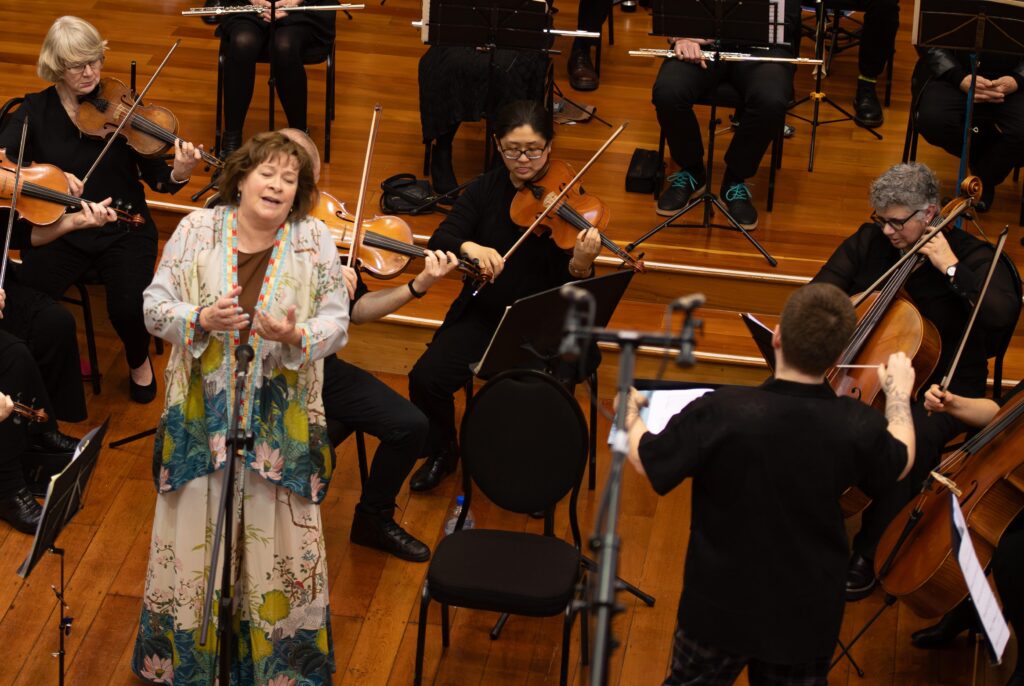 Anna Gawn performs Ross Harris’s Klezmer Suite with Rachel Hyde conducting the Wellington City Orchestra
Anna Gawn performs Ross Harris’s Klezmer Suite with Rachel Hyde conducting the Wellington City Orchestra
Wellington City Orchestra presents:
Music by BERLIOZ, ROSS HARRIS, TCHAIKOVSKY
HECTOR BERLIOZ – Marche Hongroise (Hungarian March) from ”La Damnation de Faust” Op.24
ROSS HARRIS – Klezmer Suite (2023)
TCHAIKOVSKY – Symphony No. 6 in B Minor Op 74 (“Pathetique”)
Anna Gawn (mezzo-soprano)
Rachel Hyde (conductor)
St Andrew’s-on-The-Terrace, Wellington
Saturday, 29th June 2024
This was a triumphant concert tinged with sadness for all associated with the Wellington City Orchestra, being the last occasion for some time on which Rachel Hyde will appear as the band’s conductor, as she’s planning to spend the next couple of years in Europe. Her long-time association with the orchestra has featured her as a regular guest conductor for a number of consecutive years.
The rapport with the orchestra players that Rachel has built up over this period obviously paid dividends in many instances today, resulting in a concert that provided plenty of thrills both of a novel and well-honed nature – a “call-to-arms” work by Berlioz to stir the blood which opened proceedings, followed by a colourfully exuberant, quixotic, whimsical and heartfelt collection of klezmer-inspired pieces by Ross Harris, and concluding with a cornerstone work of the romantic orchestral repertoire, Tchaikovsky’s Sixth Symphony, the “Pathetique”. I thought that, as a collection the pieces both drew from and played off one another in a satisfying archway of presentation, incident and reaction for all concerned.
The last time I heard the Berlioz work in concert was, I think, as part of an NZSO presentation of the complete “La Damnation de Faust” under conductor Edo de Waart as long ago as 2017 – whether as part of a dramatic scenario or as a concert item, the March, whose origin was a song recalling the deeds of a legendary eighteenth-century Hungarian patriot, Francis II Rákóczi, which Berlioz adapted for his “dramatic legend”, never fails to generate palpable audience enthusiasm, as it did here. If things got off to a somewhat muffled opening fanfare-beginning from the brass (who redeemed themselves handsomely in due course), the piece’s rhythmic gait was most adroitly picked up by the perkiness of the wind-playing and their full-blooded exchanges with the strings. The brass, too, soon seemed to have cleared their throats, with some properly portentous responses to the heroic major-key exhortations of winds and strings in the music’s middle section.
Hyde kept the tempo rock-steady throughout the piece’s martial exchanges, allowing the tensions to build surely and excitingly, and encouraging the percussion to “let-er-rip” along with the brass, before swinging magnificently into the march theme’s final full-throated glory, carrying us all along with the music’s brazen trajectories – and the conductor’s superb control of the famous final chord, with its crescendo-decrescendo flourishings made for a breathtaking end-moment of which the players could all be proud!
It must have been like greeting an old friend for Rachel Hyde to programme Ross Harris’s Klezmer Suite, the next item on the agenda – she and the Kapiti Chamber Orchestra had commissioned and premiered this work the previous year. I wasn’t sure quite what to expect from it all, but I needn’t have worried as to the efficacy of such a delightful amalgam of ritualised song and dance as was given here. In fact, though written in a similarly worlds-apart style, Ross Harris’s work somewhat unexpectedly reminded me in places of David Farquhar’s Dance-Suite Ring Round the Moon in terms of its transposition from a language and culture equally as removed from Aotearoa New Zealand but having an ease and universality of expression and feeling which allowed the listener to readily enter and enjoy its distinctive world.
Harris took a number of dance-like movements from the repertoire of his Klezmer Band “The Kugels” and orchestrated them, interspersing these different “moods” with several Yiddish songs, written for the soloist Anna Gawn (the soloist for last year’s premiere performance), settings of verses by various Yiddish poets, The opening dance-like “Shteti Tanz” (Simple Dance) set the atmosphere for the suite, lively, edgy, almost neo-Bartokian in flavour, and contrasting strongly in mood with the following “Dos lid fun a meydi” (The Song of a girl), a beautiful performance by singer Anna Gawn, her hands as expressive as her voice, and with flavoursome support from strings, clarinet and horn.
The orchestra-only pieces contrasted moods such as the brooding, meditative darkness of “Trit bay trit” (Step by Step) whose lower strings and brass darkly supported a plaintive, emotion-filled violin melody, and the two more energetic pieces, firstly “Hanoi” (To have fun) – an almost nihilistic “eat, drink and be merry” general dance – and “Narish” (Silly) which seemed to characterise a burlesque mood with clowns or knockabout comics doing their thing! The final piece, a song “Shtil iomir ale farshvindn” (Softly, let us all vanish) re-established the heartfelt mood, voice and oboe together generating a lamenting, almost “lost” quality, with every note, song or played, made to “speak” simply and sincerely.
Complementing the “Suite” generously was an encore, again performed by the singer, but this time accompanied by Ross Harris himself on the accordion and a fellow-member of “The Kugels, violinist Robin Perks. The song was one of those “Impossible task” folk-tales involving lovers trying to “prove” their feelings for one another via deeds of wishful veracity (a kind of Yiddish “Scarborough Fair”, perhaps?), here with a spacious, atmospheric introduction from the solo violin and with orchestral violins supporting the singer’s expressive tones, the words of the song augmented by what seemed like brief but telling vocal melismas, all very moving and heartfelt.
After this, and an interval allowing us to put something of an aura all about what we had heard, the players filed back onto the platform for the concert’s concluding business, the great “Pathetique” Symphony by Tchaikovsky one of romantic music’s most durable utterances judging by its seemingly limitless popularity. Having heard the work on countless occasions I had found myself wishing beforehand that Rachel Hyde had chosen something less frequently performed – but as soon as the lower strings had ushered in the bassoon solo that began the work I found myself drawn into it all over again! – what made it special on this occasion was that I was sitting right in the front row of the audience, and thus almost “with” the violinists, and able to observe their fingerings, bowings and vibrato-ed phrasings almost like a voyeur!
What I gained from this experience was an awareness of the richness and subtlety of the composer’s writing for the strings all though the players’ opening exchanges and interactions with the winds – I’d never realised quite to the same extent how “Mozartean” Tchaikovsky’s writing was here, how he would “share” his themes among the instruments, and sometimes in unexpected ways with the lower strings, making them play higher and lighter in places than one might expect. I thought Rachel pushed the players along to their utmost capabilities in places, so that sometimes the exchanges didn’t quite dovetail as precisely as they might – but they always “found” each other again. The strings ascended to the beginning of the “famous” melody beautifully, and with support from brass that seemed happier than in places near the beginning of the work, the tune was given a pliable, breathing shape, nicely contrasted by the winds’ ascending melody, with flute, clarinet, oboe and bassoon each playing their part. The return of the string melody at a higher voltage, with the brass in sharp attendance was heartwarming, the emotion palpable and pulsating!
The thunderclap of the succeeding allegro was terrific! – conductor and players put across the agitations with trenchant energy, growing the sounds towards the first climax with thrilling intensity and with the brass holding their lines through the “Russian Requiem” theme. Just as pungent were the exchanges between strings and winds that followed, capped by piercing piccolo shrieks and swept along by stuttering brass towards the second, all-out climax, all sections giving their all! After these detonations were done, the basses heaved themselves upwards once again and beckoned everybody back to life once more, timpani and clarinet surviving a moment of realignment before pouring oil on the troubled waters, leaving the coda’s brasses creditably holding their notes and restoring peace.
The 5/4 movement that followed was given a swift, evanescent reading, the players on their toes at their conductor’s urgings, though with the detailings still sounding a little rushed and the dovetailings the first time round stretching to properly “connect” – the music’s flow settled as the movement went on, though some details, such as the strings’ pizzicato notes didn’t quite have the space to “sound” with sufficient clarity. The players sounded more at ease in the “Trio”, the ebb and flow of emotion filling out more spaciously and focusedly.
No such reservations about the third and fourth movements! I felt, right from the scherzo’s beginning, that Rachel had hit the “tempo giusto”, the players filling out their spaces with confidence and verve (I loved the piccolo playing, which always had such a “presence”!). The famous “march tune” announced itself with a crash and swung into view with a vengeance, mid-movement – a great moment, and with the string triplets wonderfully incisive! And what excitement conductor and musicians built up as the crescendo’s sounds rose up to greet us, with the percussionists having the proverbial field day at the back as the whole orchestra magnificently roller-coasted its way to the end – never mind about the slight hit-and-miss payoff!!
A great and noble account of the last movement followed (again, the string writing from where I was sitting sounded amazingly “layered” and detailed!) Rachel and her players encompassed all the sadness, despair and fatalistic gloom implied by Tchaikovsky’s writing, by turns full-blooded and sensitive. Apart from an initial brass burble and a slightly premature string entry, the major-key section of this movement was most affectingly grown, the strings singing crazily and the winds and brass joining in for all they were worth, making the movement’s subsequent death-throes all the more appalling, with the positively ghoulish muted brass particularly cruel and mocking, as was the single gong-note and fate-laden brass afterwards – all that was left was for the orchestra to weep amidst growing silence.
I would imagine that Rachel herself, her players and the orchestral staff were thrilled with the results of their efforts in every way, and not the least with the audience reaction to it all – there was cheering and foot-stamping at the end and a genuine feeling afoot that we had all been witness to something exceptional, besides the realisation that this was an occasion that won’t be repeated for a while to come, with Rachel’s departure pending. However, legends are made of this kind of stuff, and everybody would have been left with his or her own sense of what made this occasion special, not the least of which was the chance to express thanks, gratitude and best wishes to Rachel Hyde for some memorable music making and many happy and fruitful times to come.
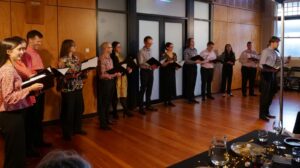 Director Michael Stewart in front of The Tudor Consort
Director Michael Stewart in front of The Tudor Consort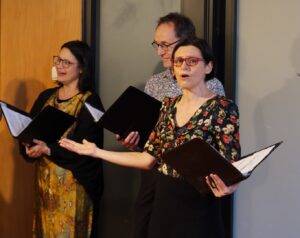 From left: Alexandra Granville, Keith Small, Rebecca Stanton (in front).
From left: Alexandra Granville, Keith Small, Rebecca Stanton (in front). Act One: Wade Kernot (Coach), Manase Latu (Count Ory), Moses MacKay (Raimbaud), NZ Opera Chorus – photo credit: Lewis Ferris
Act One: Wade Kernot (Coach), Manase Latu (Count Ory), Moses MacKay (Raimbaud), NZ Opera Chorus – photo credit: Lewis Ferris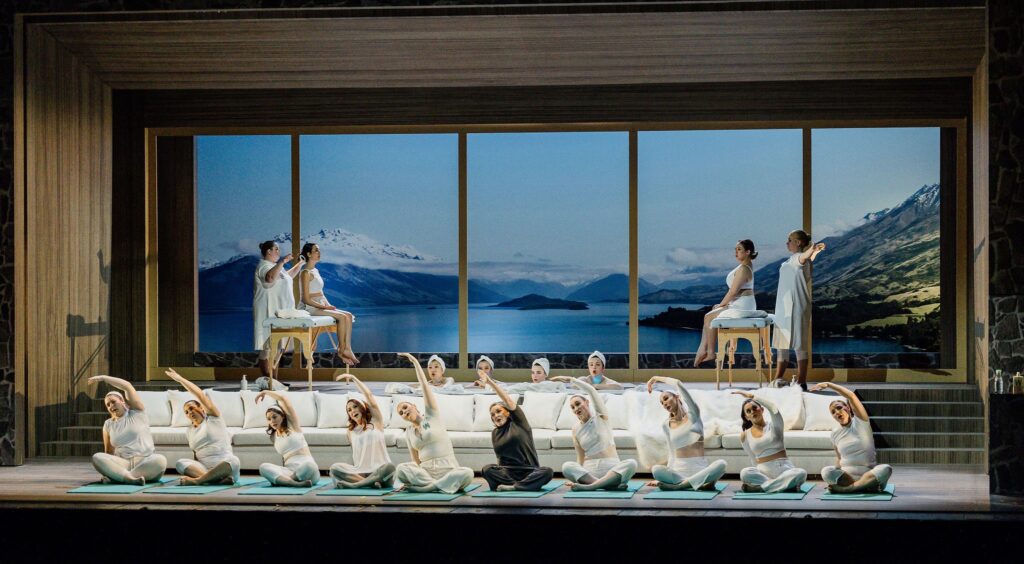 Le Comte Ory – Act Two (beginning) – NZ Opera Chorus, with Emma Pearson (Countess Adele), Tayla Alexander (Alice) and Andrea Creighton (Ragonde)
Le Comte Ory – Act Two (beginning) – NZ Opera Chorus, with Emma Pearson (Countess Adele), Tayla Alexander (Alice) and Andrea Creighton (Ragonde)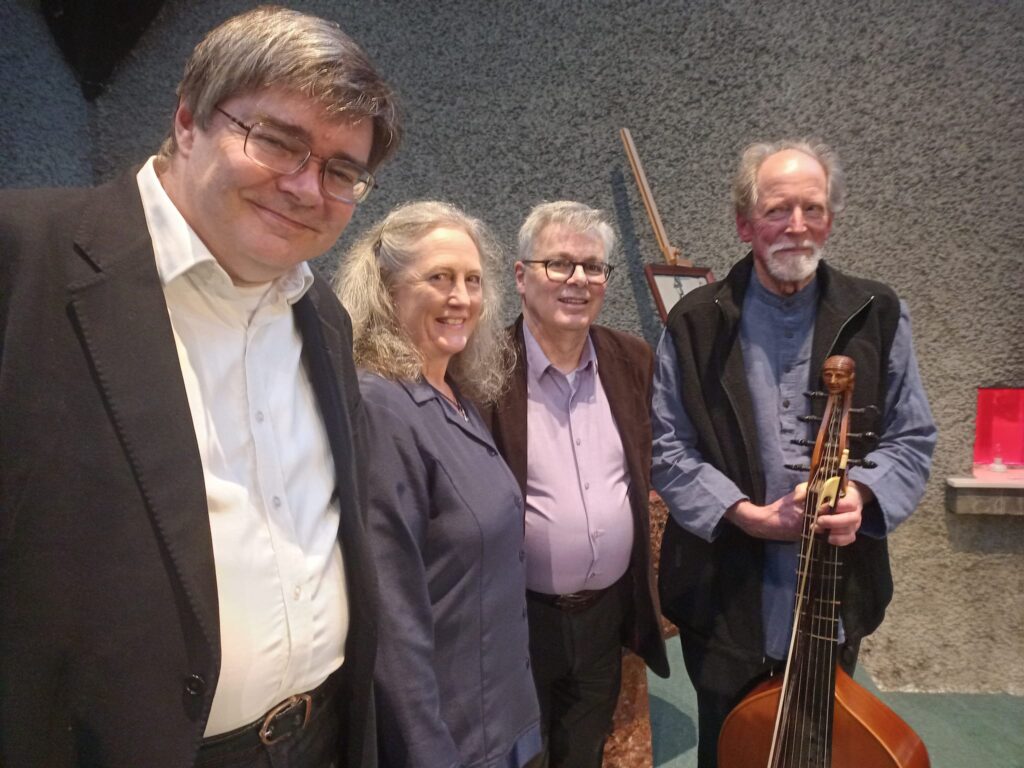 David Morriss (bass), Pepe Becker (director, soprano), Douglas Mews (keyboards), Robert Oliver (bass viol)
David Morriss (bass), Pepe Becker (director, soprano), Douglas Mews (keyboards), Robert Oliver (bass viol)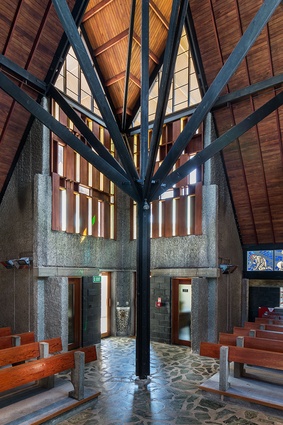 Futuna Chapel, Karori
Futuna Chapel, Karori
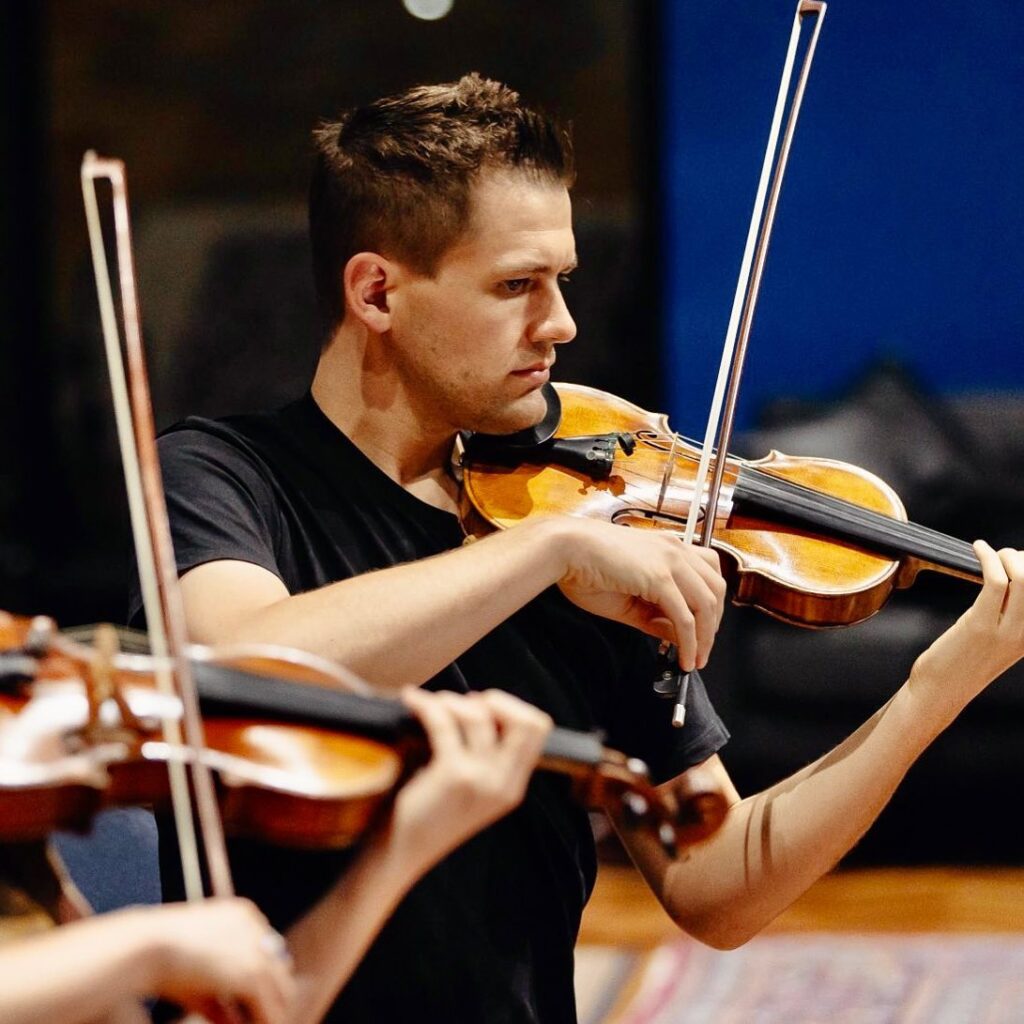 Peter Clark
Peter Clark